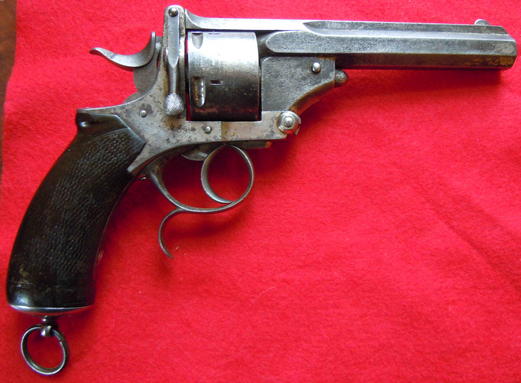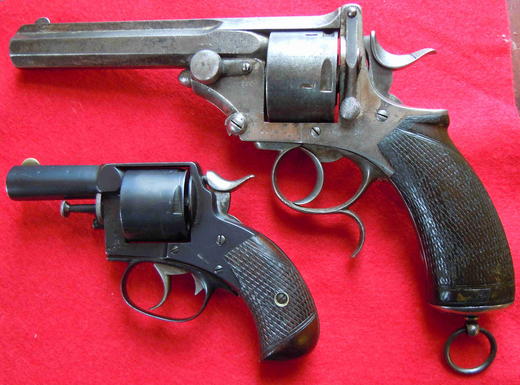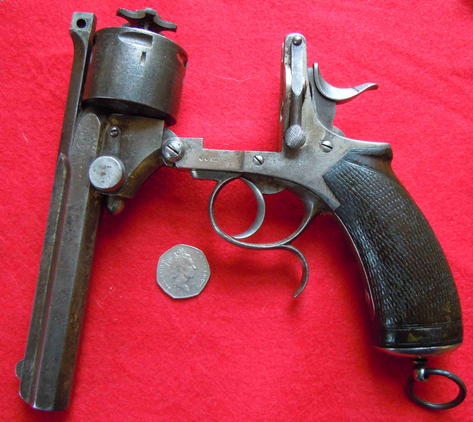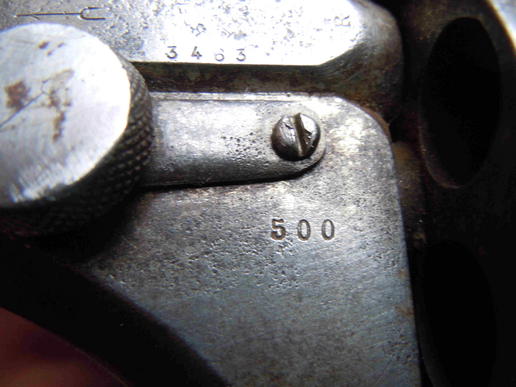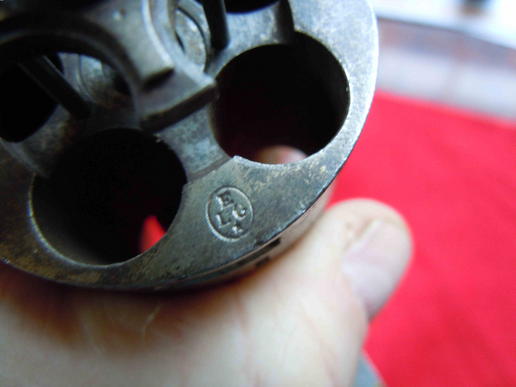Huge Webley Pryse Style Counet .500 revolver
Other than some surface roughness and minor pitting here and there, this revolver is in surprisingly good condition after at least 120 years of existence. And this was one of the biggest shooting machines available especially for British Officers as well as for any others who wanted a true man-stopping firearm (see paragraph below). The action works quite well both SA and DA and the lock-up is fairly tight with some minor movement in the cylinder. The bore is in very good condition with strong rifling and some minor pits here and there. The extraction system operates just as it should. The original nickel is only found in a few spots and small areas, otherwise the lines and marks are good. There is more minor surface pitting on the barrel and barrel assembly (as well as some larger areas on the cylinder), and unfortunately one of the spots of noticeable surface pitting is right where the original marks are stamped at the left rear of the barrel. But the marks are still visible enough to work out the following: BREVET COUNET, 3463 - this number is most likely a patent number because the serial number is stamped further down on the action itself: 4482. The caliber of 500 is also stamped on the left of the barrel assembly. This revolver is a classic Counet with the large headed bolt on the left, which when turned with the arrow pointing back allows the center post to be removed. The revolver uses the Pryse system for the opening of the top-break mechanism. This is the full Pryse system with the two fingers that lock bolts into both sides of the post on the rear of the barrel assembly while adding a bit of complication to the top-break system the Pryse locking mechanism was a much safer system than the type of lock used on the Smith & Wesson (and its copiers). The revolver also has the finger rest under the trigger guard, which in the handling of the larger revolvers really does help in steadying the gun for firing; it doesnt help on any quick draw attempts, but a gun this big wasnt designed either for fancy draws nor for spinning in the hand. The grips are in good condition showing normal wear, and the entire original pattern is still present. For size comparison I have shown the revolver next to a Webley .450 Calibre Bulldog, itself a "chunky" revolver, the Counet .500 is substantially larger, and that with only 5 chambers! The barrel measures 5-5/8 inches (142mm), and overall the revolver is 10-5/16 inches long (262mm). The revolver is marked on the rear of the cylinder with the inspectors mark of a star over R (1877 to 1968) and the pre-1894 Liege proof. This proof was the very best in Europe in the 19th century; each chamber had to be proofed or proved by firing a double load 4 times. No junk ever got past that proof. Several manufacturers in Great Britain, France and Germany sent their finished small arms to Belgium just for this proof. Altogether this is a fine Counet/Pryse system revolver manufactured in Belgium to some of the strictest requirements in 19th century Europe.
THE COUNET-PRYSE PATENT: Phippe Counet patented this particular revolver in Liege in 1876 and it was available in chamberings from .320 right up to .500 Webley, as with this one. We actually found one about 5 years back that was chambered for the monster .577 cartridge. Philippe Counet was registered for proof tests in Liege between the years of 1865 and 1905. Having the 1877 inspection mark as well as the pre-1894 Liege proof means that this revolver was manufactured sometime in this period. But I assume it was made closer to 1880 when the .500 Webley round came out.
A MARKET AMONG BRITISH OFFICERS: Although the big-bore Belgian and British revolvers were sold commercially to anyone who wished to haul a cannon around, the main market to which these were directed was the officer corps among the British armed services. The Zulu troubles in South Africa and uprisings in Sudan had taught the British Military that they needed handguns that were chambered for something more powerful that the .450 Adams cartridge that had been the first centerfire, brass cased cartridge to be used by the British. The British eventually chambered their ordinance revolvers in the new .455 (sometimes called the .476) in 1892. But in answer to the call of the officers themselves, who had to purchase their own sidearms, the .500 Webley or .500 Tranter cartridge had already appeared sometime about 1880 (see paragraph below). The .500 Webley revolver became almost the sidearm of choice for hundreds of British officers who wanted a big enough punch to actually stop in their tracks any attacking enemy (and in most cases kill them with one shot). The only commerical cartridge that surpassed the .500 was truly big .577 Webley. That was a round that was not topped in overall impact (and pure destruction), even with its relatively slow velocity, until the .41 Magnum appeared in 1964. The only setback to packing a .577 Revolver around was the huge machine that had to be built around the bullets. It was the kind of revolver that was more often kept under the seat on a wagon or stage than in a holster, because all that weight in a holster either caused a horribly lopsided stride or worse, brought about the embarrassing phenomenom of encounting ones trousers around the ankles. Even the big .500 requires a strong hand and steady aim, and was never the favorite revolver of the quick draw crowd. The battle experience of British Officers using this big round was enough to keep interest high and keep manufacturing of these revolvers and their ammo profitable right up into the first decades of the 20th century.
THE .500 WEBLEY CARTRIDGE: The .500 Webley or .500 Tranter revolver cartridge, was introduced around 1880 in England for use in revolvers based on the Tranter and Webley patents. It was designed in answer to the call of British officers for a truly man-stopping handgun cartridge. The bullets weighed in the range of 340 to 350 grains and developed about 650 fps with its black powder load (that doesnt sound like a screaming bullet, but nothing was left standing when it hit). British production of the cartridge ended by 1920;
Code: 50063

